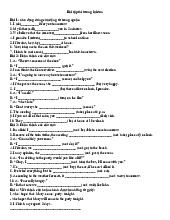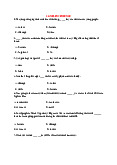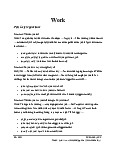


Preview text:
REVIEW 1
I/ TRUE/FALSE: Decide whether each of the following statements is TRUE or FALSE.
1. Phonetics is the study of how speech sounds in a language are produced,
transmitted and perceived. F
2. All vowels are either voiceless or voiced. F luôn là voiced
3. The rise could be said to give an impression of finality(false). F
4. When the air moves through the oral cavity, bi-labial sounds /p/, /b/, /m/ appear. F
5. Acoustic phonetics studies the perception of speech sounds. F
6. A vowel is a sound in the production of which there is a complete closure in the vocal tract. F
7. The most important thing to remember about all the diphthongs is that the first part
is much longer and stronger than the second part. T
8. Speech sounds are divided into pure vowels and diphthongs. F
9. Falling tone conveys an impression that something more is to follow. F
10. Stress is defined as the prominence given to certain syllable in a word or to certain
words by the use of greater breath force. T
11. The tongue is a passive articulator. F
12. When we say a consonant is plosive, nasal, lateral, or affricative, we are
classifying it according to the manner of its articulation. T
13. An allophone is a smallest unit of sound in a language that can distinguish one
word from another. F phoneme
14. The complete internal structure of a syllable is: ONSET (consonant) + NUCLEUS
(consonant) + CODA (vowel). F vowel
15. Vowels can be classified into long and short vowels according to the height to
which a part of the tongue is raised. F length
16. The affixes -ese, -eer, and –ee carry the primary stress in a word. T
17. Centring diphthongs are those which end in /i/. F
18. Nasal, oral and pharyngeal cavities function as the principal resonators. T
19. Phonology studies all the speech sounds and the ways in which they are produced. F
20. Allophonic/phonetic transcription is based on the principle "one symbol per phoneme". F allophone
21. The term accent is often used to refer to a particular way of pronunciation. T
22. All consonants are syllabic sounds. F l, b
23. Distictive features are particular characteristics distinguishing one distinctive unit
of sound in a language from another. T
24. Ordinarily is a word consisting of two syllables. F
25. When we add the suffix –ful to an English word such as careful, the word-stress
will fall on the suffix –ful. F
26. Assimilation is the deletion of a vowel in casual speech. F elision
27. Sentence stress is greater prominence with which one or more words in a sentence
are pronounced as compared with other words of the same sentence. T
28. Intonation can be used to serve the grammatical function. T
29. Assimilation is called regressive when the sound that comes first affects the sound
that comes after it. F progressive
30. Lexical words are usually not stressed in speech. F
II/ MULTIPLE CHOICE: Choose the best answer among A, B, C, D.
1. Which of the following is a passive articulator? A. the pharynx B. the velum C. the tongue D. the hard palate
2. Which of the following is NOT used as a criterion for consonant classification? A. the position of the velum B. the manner of articulation C. the place of articulation
D. the shape of the lips
3. Which of the following words has the stress on the last syllable? A. teaching B. engineer C. joyful D. happiness 4. The glottis is thanh môn
A. the space between the velum and the back of the tongue.
B. the soft appendage hanging down from the velum. C. also called the larynx
D. the space between the vocal cords.
5. .................. may be defined as one or more speech sounds forming a word or part of a
word, containing one vowel sound, with or without a consonant or consonants, and uttered at a single effort. A. The morpheme B. The intonation C. The syllable D. The phoneme
6. Which of the following is NOT true?
A. The phoneme is the smallest distinctive unit of sound in a language.
B. The allophones of the same phoneme are complementary distribution. Phân b ố bổ sung
C. The allophones of the same phoneme must occur in different phonetic contexts. Lip girl
D. The allophones of the same phoneme must occur in the same phonetic contexts.
7. .......... always occurs in English syllable. A. Consonant B. Vowel C. Intonation D. Coda
8. The fall intonation is used in A. YES/NO questions B. statements C. listing D. alternative questions
9. When voiced sounds are articulated, the vocal cords are A. raised B. lowered C. vibrating D. having no function
10. The intonation type used in the utterance A year later, she was divorced is A. fall B. fall-rise C. rise D. rise-fall
11. The following describe the manners of articulation EXCEPT A. plosive B. fricative C. alveolar D. nasal
12. Which of the following pairs belongs to the alveolar plosive? A. /b/ & /d/ B. /t/ & /d/ C. /p/ & /b/ D. /t/ & /g/
13. High and low vowels are classified according to
A. the height of the tongue B. the part of the tongue involved C. the length of the vowels D. the shape of the lips
14. When an oral sound is articulated t o ra ạ
A. the airstream escapes through the nose. B. the velum is raised.
C. the airstream cannot move out of the mouth. D. the velum is lowered vòm mi ng ệ
15. A combination of two vowels pronounced within one syllable is called……… A. a front vowel B. a closed vowel C. an open vowel D. a diphthong
16. Sounds like [f], [s], [∫] are called A. stops B. affricatives C. fricatives D. alveolar
17. Speech melody, a component of intonation, is the variation in............. A. tempo of speech B. sentence stress
C. the pitch of the voice D. special colouring of the voice
18. Which of the following word contains a syllable of structure C + syllabic C? A. simple B. heart C. reach D. stop
19. In English, a syllable is generally NOT formed by A. one vowel B. one vowel + one consonant C. one consonant + one vowel D. two stop consonants
20. Which of the following is not a segmental phoneme? Đ n v ơ đo ị n tính ạ A. the vowel B. the stress C. the consonant D.the diphthong III/ PROBLEM SOLVING:
A. Identify the phonetic features of the following pair of phonemes: 4 distinctive features
/f/ and /j/; /h/ and /d/
B. Draw the diagrams to show the internal structures of the following syllables: LEARNT, BIRDS




